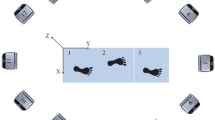Abstract
The number of people with difficulty in walking has increased with aging issues worldwide. It is possible to regain walking ability after persistent locomotion training. With the development of robotics, cyclic walking motion is implemented to stimulate the correct walking pattern. In order to better track the planned walking motion, this paper focuses on the “repetitive” motion input for the lower limb, and the intelligent control algorithm is proposed to diminish the tracking error. Repetitive control algorithm, based on the characteristics of a cyclical input signal and the internal model control principle, implanted the periodic signal generator has developed into the closed-loop system in order to achieve steady tracking of cyclic reference signals and rejecting disturbance on the rehabilitation robot. Results are applied on the simulation model of a bedecked overground walking gait system. It shows the effectiveness of the proposed method compared with the conventional PD controller.








Similar content being viewed by others
References
Wang P, Low KH, Tow A (2010) Effects of body-weight support locomotion training (BWSLT) on EMG activation in healthy and spinal cord injury (SCI) subjects. In: IEEE International Conference on Robotics and Biomimetics (ROBIO), 2010, pp 271–276
Wang P, Low KH, McGregor AH, Tow A (2013) Detection of abnormal muscle activations during walking following spinal cord injury (SCI). Res Dev Disabil 34:1226–1235
Liuping W, Shan C, Rogers E (2010) Predictive repetitive control based on frequency decomposition. American Control Conference (ACC) 2010:4277–4282
Longman RW (2000) Iterative learning control and repetitive control for engineering practice. Int J Control 73:930–954
Kaneko K, Horowitz R (1997) Repetitive and adaptive control of robot manipulators with velocity estimation. IEEE Trans Robot Autom 13:204–217
Wei R, Balasubramanian S, Xu L, He J (2008) Adaptive Iterative Learning Control design for RUPERT IV. In: 2nd Biennial IEEE/RAS-EMBS International Conference on Biomedical Robotics and Biomechatronics, BioRob 2008, 19 Oct 2008–22 Oct 2008, Scottsdale, pp 647–652
Xiaoke F, Xing L, Jianhui W, Liang D (2010) Repetitive control of rehabilitation robot with multi-channel periodic input signal. In: Intelligent Control and Automation (WCICA), 2010 8th World Congress on 2010, pp 6605–6609
Wang P, Low KH, McGregor AH (2011) A subject-based motion generation model with adjustable walking pattern for a gait robotic trainer: NaTUre-gaits. In: 2011 IEEE/RSJ International Conference on Intelligent Robots and Systems (IROS), San Francisco (2011)
Okamoto S, Lee JH, Fujieda H (2013) Computational and experimental analyses on impact reduction when a humanoid robot lands on the ground. Artificial Life and Robotics 18:212–218
Motonaka K, Watanabe K, Maeyama S (2014) Offline gain optimization in kinodynamic motion planning based on a harmonic potential field. Artificial Life and Robotics 19:47–54
Koceska N, Koceski S, Zobel PB, Durante F (2008) Control architecture for a lower limbs rehabilitation robot system. In: IEEE International Conference on Robotics and Biomimetics (ROBIO), Bangkok, Thailand, pp 971–976
Erol D, Mallapragada V, Sarkar N, Uswatte G, Taub E (2005) A new control approach to robot assisted rehabilitation. In: IEEE 9th International Conference on Rehabilitation Robotics (ICORR), Chicago, pp 323–328
Buerger SP, Hogan N (2007) Complementary stability and loop shaping for improved human-robot interaction. IEEE Trans Rob 23:232–244
Emken JL, Harkema SJ, Beres-Jones JA, Ferreira CK, Reinkensmeyer DJ (2008) Feasibility of manual teach-and-replay and continuous impedance shaping for robotic locomotor training following spinal cord injury. IEEE Trans Biomed Eng 55:322–334
Zhang JF, Dong YM, Yang CJ, Geng Y, Chen Y, Yang Y (2010) 5-Link model based gait trajectory adaption control strategies of the gait rehabilitation exoskeleton for post-stroke patients. Mechatronics 20:368–376
Yoon J, Novandy B, Yoon CH, Park KJ (2010) A 6-DOF gait rehabilitation robot with upper and lower limb connections that allows walking velocity updates on various terrains. IEEE/ASME Trans Mechatron 15:201–215
Ying-Yu T, Rong-Shyang O, Jung SL, Meng-Yueh C (1997) High-performance programmable AC power source with low harmonic distortion using DSP-based repetitive control technique. Power Electronics, IEEE Transactions on 12:715–725
Wang JH, Li X, Fang XK, Dong L, C. Northeastern Univ (2010) Single-joint Repetitive Control of Upper-limb Rehabilitation Robot. In: Control and Decision Conference (CCDC), China, 26–28 May 2010, p 1330
Wang P, McGregor A, Tow A, Lim HB, Khang LS, H. Low K (2009) Rehabilitation control strategies for a gait robot via EMG evaluation. In: IEEE 11th International Conference on Rehabilitation Robotics (ICORR), Kyoto, pp 86–91
Acknowledgment
Thanks to the support of the Special Fund for Basic Scientific Research of Central Colleges, Chang’an University, China (No. 2014G2320006, 2013G3322009, 2014G1321040) and the Key Science and Technology Program of Shaanxi Province, China (Grant No. 2013JC2-25)
Author information
Authors and Affiliations
Corresponding author
About this article
Cite this article
Wang, P., Li, L., Yan, M. et al. Repetitive control for the periodic walking training in a gait rehabilitation robot. Artif Life Robotics 20, 159–165 (2015). https://doi.org/10.1007/s10015-015-0203-3
Received:
Accepted:
Published:
Issue Date:
DOI: https://doi.org/10.1007/s10015-015-0203-3




